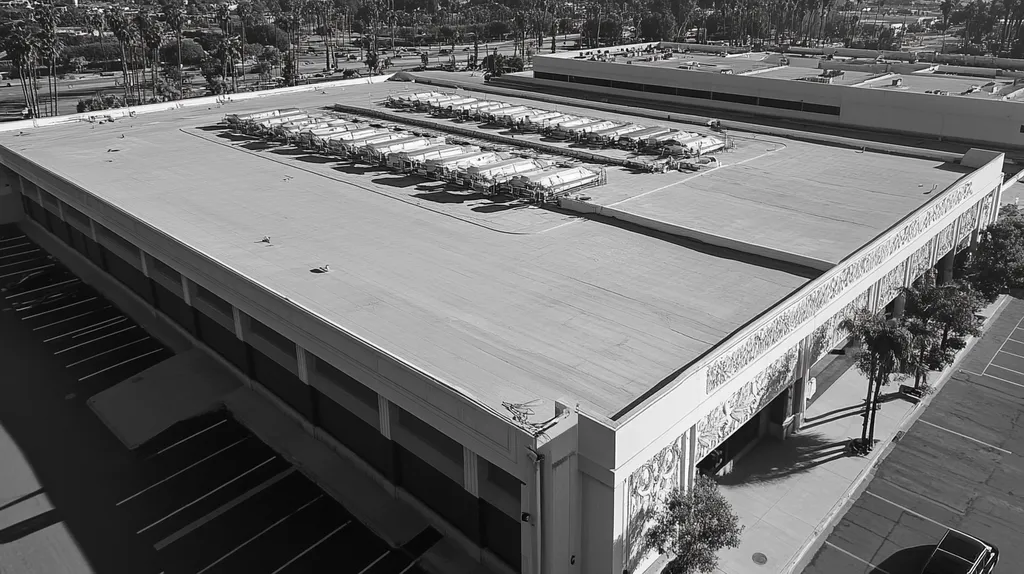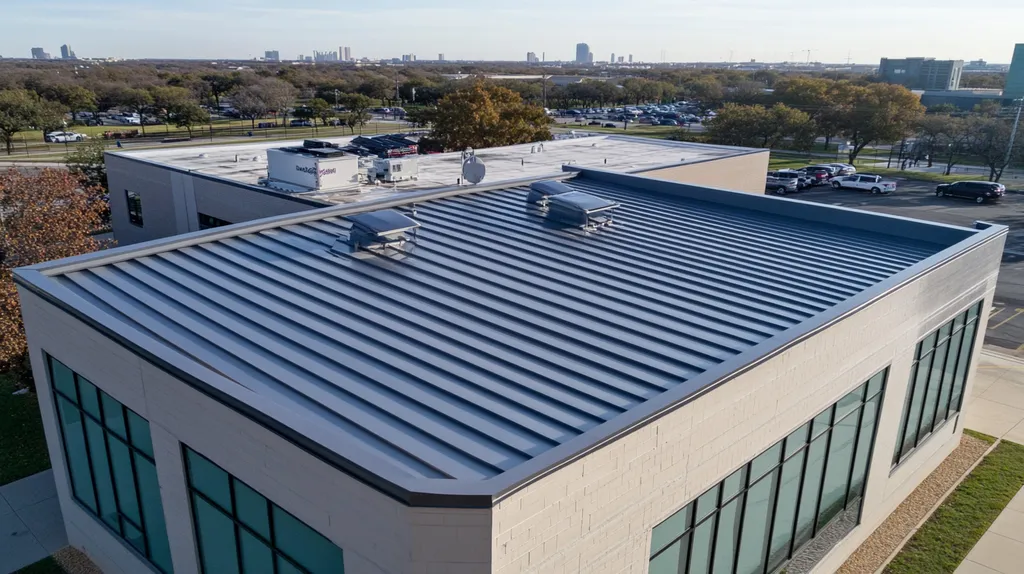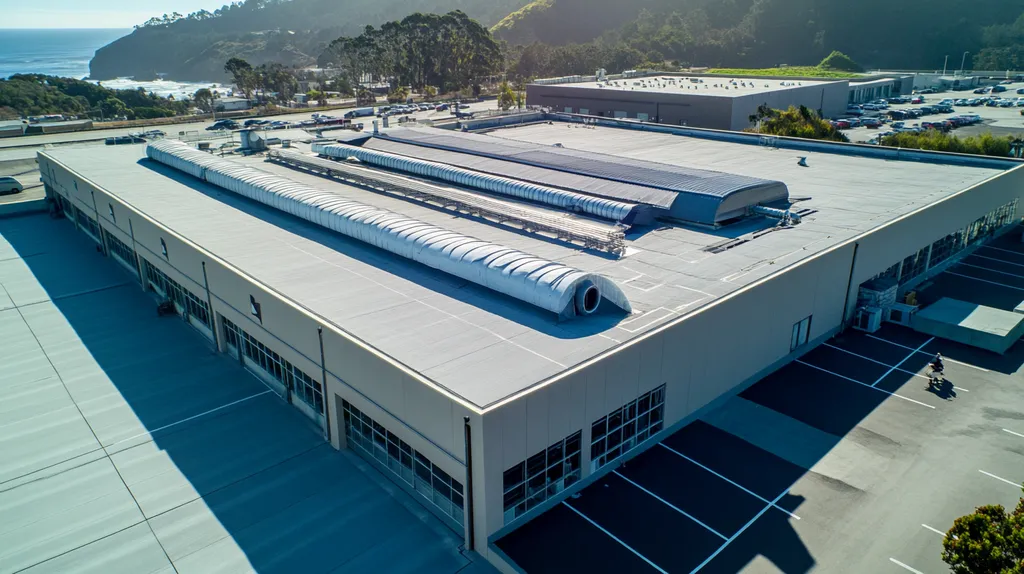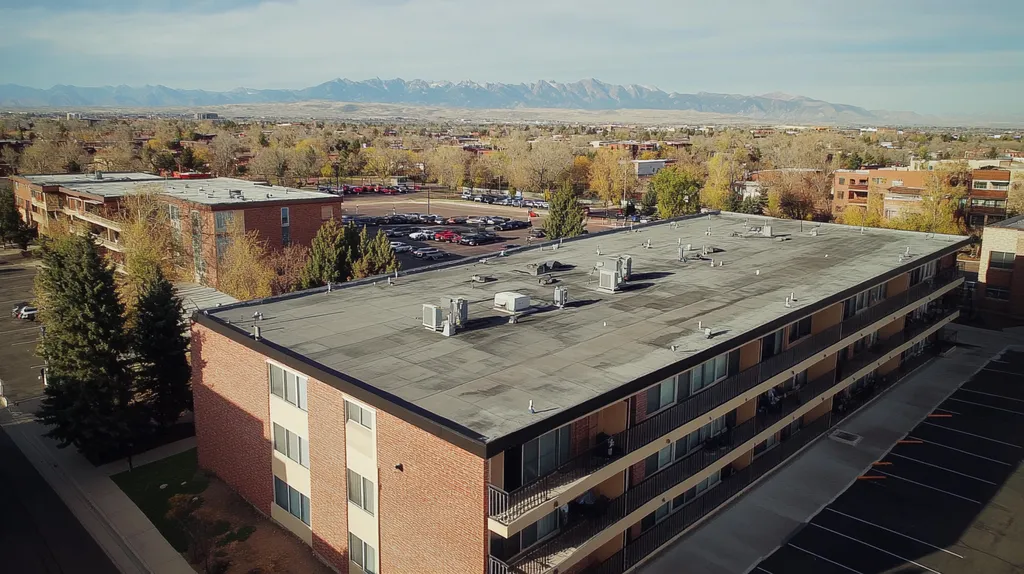Every year, commercial property owners lose millions of dollars due to failed roof coatings, with studies showing that 40% of all commercial roof problems stem from coating deterioration.
Understanding the warning signs of coating failure can mean the difference between a simple repair and a complete roof replacement, potentially saving businesses tens of thousands in emergency repairs.
This comprehensive guide examines the critical indicators of commercial roof coating failure, from early warning signs to advanced deterioration patterns, equipping property managers with the knowledge to protect their investments.
SECTION 1: FUNDAMENTAL CONCEPTS
Grasping the fundamentals of commercial roof coatings is essential for property owners and facility managers alike. Alarmingly, up to 30% of commercial roofs fail prematurely due to inadequate maintenance or coating issues. By understanding the different types of coatings available, their distinct benefits, and how they function, property owners can make more informed decisions. This knowledge is crucial for safeguarding investments and prolonging the lifespan of roofing systems.
Definition of Commercial Roof Coatings
Commercial roof coatings are specialized protective layers applied over existing roofing systems. These coatings act as a shield against harsh environmental factors, significantly enhancing a roof’s durability. Their primary roles include providing waterproofing, UV resistance, and added insulation, which are vital for maintaining overall roof integrity.
These coatings are versatile and can be used on various roofing types, such as metal, built-up, and single-ply systems. When applied correctly, they can dramatically extend the life of a roof while decreasing maintenance costs. This proactive approach not only saves money in the long term but also boosts energy efficiency.
Additionally, roof coatings can turn flat surfaces into useful spaces that are safe for walking and can even support lightweight equipment. Having a solid understanding of these coatings sets the stage for recognizing their importance and identifying early signs of potential failure.
Ultimately, a thorough comprehension of commercial roof coatings empowers property owners to take proactive measures that protect both their structures and their investments.
Types of Roof Coating Materials
The market offers several types of roof coating materials, each with unique advantages designed for specific roofing needs. The most commonly used materials include elastomeric, acrylic, polyurethane, and silicone coatings.
Elastomeric coatings, with their rubber-like flexibility, are particularly effective in climates subject to temperature swings. In contrast, acrylic coatings are water-based, providing good UV resistance but requiring more frequent reapplications.
Polyurethane coatings are robust and excel in resisting chemicals and wear, making them ideal for high-traffic areas or challenging environments. Silicone coatings stand out for their moisture resistance, making them especially effective on roofs prone to standing water.
Each type necessitates specific application techniques and maintenance schedules. By understanding these materials, property owners can select the most appropriate option tailored to the specific conditions of their facilities.
Benefits of Roof Coatings
The advantages of applying roof coatings go well beyond mere appearance; a well-selected coating can extend a roof’s lifespan by 10 to 20 years. Such longevity can significantly lower replacement costs and minimize business disruptions.
Moreover, roof coatings enhance energy efficiency by reflecting harmful UV rays, leading to lower cooling expenses. Studies reveal that reflective coatings can decrease roof temperatures by as much as 30%, yielding impressive energy savings.
These coatings also provide essential waterproofing, helping to prevent leaks and potential water damage. By protecting building assets and lowering maintenance costs, roof coatings can be a smart financial decision over time.
Additionally, minimizing the need for costly roof replacements makes coatings an economically wise choice. They also contribute to sustainable practices by reducing waste, aligning with modern green building initiatives.
SECTION 2: SYSTEM COMPONENTS
Understanding the key components of a commercial roof system is critical for detecting signs of failure. Over 30% of commercial roofs fail due to improper integration of materials, leading to water damage and costly repairs. Recognizing how roofing membranes and coatings interact, the importance of flashing and sealing, and effectively managing roof penetrations and equipment can empower property owners to protect their investments. This section will explore these vital elements in detail.
Roofing Membrane and Coating Interaction
The interaction between the roofing membrane and coating is vital for the performance of the entire roof system. Choosing the wrong coating can jeopardize the membrane’s integrity, resulting in premature failure. For example, when a coating lacks proper adhesion, it can peel, crack, or allow water to penetrate, leading to extensive damage.
Material compatibility plays a key role in durability as well. If the membrane and coating are made from different materials, negative chemical reactions may occur, degrading both the membrane and the coating over time. Regular inspections should emphasize checking for signs of adhesion issues and surface wear.
By consulting with roofing professionals before applying a coating, property owners can ensure the compatibility of materials. This proactive step significantly reduces risks of failure.
Ultimately, seamless integration between the roofing membrane and coating leads to longer roof life. Recognizing this interaction is essential for effective roof management.
Flashing and Sealing Components
Flashing and sealing components serve as the first line of defense against water intrusion. They protect vulnerable areas where the roof meets vertical structures, such as walls and chimneys. If these components fail, water can seep into the underlying layers, resulting in extensive damage.
Common issues such as cracking, bending, or detachment of flashing signify potential failure, while failed sealants can create gaps for moisture entry. This can lead to mold growth and structural complications if left unaddressed.
To prevent these problems, regular maintenance is crucial. Property owners should inspect flashing and sealing components at least twice a year to confirm their integrity. Quick action in repairing or replacing faulty flashing can significantly enhance a roof’s lifespan and safeguard the property’s value.
Penetrations and Roof Equipment Integration
Roof penetrations, including vents and HVAC units, present unique challenges in maintaining a watertight roof. Improper sealing around these areas is a primary cause of leaks. For example, an ill-fitted HVAC unit can create gaps that allow water to infiltrate.
Moreover, the natural expansion and contraction of roofing materials over time can wear down seals if not adequately managed. Regular inspections focused on seals and gaskets around penetrations should be performed to identify wear early.
Ensuring that roof equipment integrates well with the roofing system is crucial for long-term performance. This includes checking that flashing is secure and seals remain intact.
By taking a proactive approach to managing roof penetrations and equipment, property owners can help prevent leaks and maintain overall roof health. Addressing these components is fundamental for effective roof management and longevity.
SECTION 3: IMPLEMENTATION METHODS
Implementing a commercial roof coating system effectively can dramatically enhance its durability and performance. However, a poorly executed application may lead to premature roof failure, resulting in costly repairs and increased liability. Alarmingly, industry data highlights that up to 20% of roof coatings fail due to improper installation methods. By understanding effective preparation, application techniques, and curing processes, property owners can significantly mitigate these risks and prolong the life of their roofs.
Preparation and Surface Cleaning
Successful roof coating begins with meticulous preparation, starting with thorough surface cleaning. Removing all dirt, debris, and contaminants is essential for ensuring the coating adheres properly. This often involves power washing or utilizing specialized mechanical cleaning methods.
Once the initial cleaning is complete, it’s vital to conduct a detailed inspection for underlying issues like cracks or blisters. Addressing these problems beforehand ensures they don’t compromise the integrity of the new coating. The surface must also be completely dry and moisture-free to achieve optimal adhesion.
Additionally, any loose or peeling remnants of previous coatings must be removed. Leftover materials can undermine the strength of the new system, making it vulnerable to early failure.
Documenting the preparation process can prove beneficial for future reference. This organized record keeping aids in making informed decisions and streamlines any future maintenance efforts.
Application Techniques and Tools
Choosing the right application technique is pivotal for successful roof coating. There are several methods available, including spray, roll, and brush applications, each catering to different needs. For expansive surface areas, spray applications may offer the most efficiency and uniformity.
The quality of tools used can greatly enhance the application process. High-quality spray rigs provide even coating distribution, while rollers specifically designed for commercial coatings ensure better adhesion and a smooth finish.
Moreover, environmental conditions significantly influence the application success. Applying coatings in unsuitable weather can lead to suboptimal results. Adhering to ideal temperature ranges ensures proper curing and reinforces the system’s overall performance.
Following manufacturer specifications during application is also crucial. Compliance with guidelines maximizes compatibility and helps ensure the longevity of the coating.
Curing and Inspection Procedures
The curing process is critical to the effectiveness of the roof coating. It allows the coating to bond with the substrate, creating a protective layer. Curing times can vary based on materials, so understanding these specifics is essential for optimal results.
Regular inspections throughout the curing phase are vital for identifying potential issues early on. Inspectors need to be vigilant for signs such as uneven surfaces or bubbling, which may indicate improper application methods. Addressing these concerns promptly can save both time and resources.
Post-curing inspections are equally important. Comprehensive assessments ensure that the coating has achieved optimal adhesion and integrity. Documenting these findings can support the development of a proactive maintenance plan for the future.
By focusing on meticulous preparation, precise application techniques, and thorough curing and inspection procedures, property owners can safeguard the longevity and performance of their roofing systems.
SECTION 4: MAINTENANCE REQUIREMENTS
Proper maintenance of commercial roof coatings is essential to ensure their longevity and effectiveness. Without regular upkeep, small issues can escalate into significant problems, jeopardizing roof integrity and the safety of the building. Remarkably, routine maintenance can extend the life of a roof coating by as much as 50%. This section will explore vital maintenance practices, including establishing regular inspection schedules, addressing repairs promptly, and implementing measures to prevent surface erosion and punctures.
Regular Inspection Schedules
Implementing a consistent inspection schedule is crucial for the upkeep of commercial roof coatings. To maximize effectiveness, inspections should occur at least twice a year, with additional checks after severe weather events like storms or hail. These inspections should focus on identifying early warning signs, such as bubbling or discoloration, which could indicate underlying problems.
Documenting findings during inspections can be especially valuable. By taking photographs, property owners can track changes over time and maintain a clear record for reference when assessing necessary repairs. Spotting issues early can save significant costs, preventing minor problems from developing into major repairs.
It’s also essential to train maintenance crews on specific signs of wear to watch for. This education empowers teams to identify and address minor issues proactively, effectively safeguarding both the roof and the well-being of building occupants.
Repairing Coating Damages and Leaks
Promptly addressing any damage or leaks in roof coatings is crucial to preventing serious complications. Common repair methods include patching and recoating areas of concern. It’s vital to select materials that are compatible with the existing coating to ensure a strong and lasting repair.
For example, if a crack appears, it should be sealed with a high-quality sealant designed specifically for roofing applications. This practice helps thwart water intrusion and additional deterioration of the underlying materials. Identifying the sources of leaks, whether through punctures or compromised seams, is key to implementing targeted repairs.
Establishing a reporting system for documenting damages and repairs will minimize potential hazards. Regular training for maintenance staff on effective repair techniques can further enhance their ability to respond quickly and efficiently whenever issues arise.
Preventing Surface Erosion and Punctures
Shielding roof surfaces from erosion and punctures is vital for long-term durability. Maintenance routines should prioritize removing debris and ensuring proper drainage to avoid water accumulation, which can erode coatings over time. Items like fallen branches, leaves, and other debris can trap moisture and accelerate deterioration.
It’s also important to manage foot traffic and the placement of heavy equipment on the roof. Designated pathways and guardrails can help mitigate physical damage. Additionally, utilizing protective pavers in high-traffic areas helps distribute weight and prevent punctures.
Applying a reflective coating can provide extra defense against UV damage. This proactive approach not only enhances the lifespan of the coating but also contributes to increased energy efficiency by reflecting heat away. By adopting these preventive measures, property owners can ensure their commercial roof coatings remain robust and effective for many years.
SECTION 5: PERFORMANCE METRICS
Monitoring the performance metrics of a commercial roof coating is crucial for property owners and facility managers. Failing to assess these metrics can lead to costly leaks, increased energy expenses, and significant structural damage. For example, a roof with poor waterproofing can result in extensive repairs and diminish the property’s overall value. This section examines three vital metrics—waterproofing integrity, energy efficiency, and coating deterioration—that are essential for maintaining an effective roofing solution.
Assessing Waterproofing Integrity
The waterproofing integrity of roof coatings is vital for their effectiveness. Regular inspections are necessary to spot signs like water pooling, cracking, or visible wear on the coating. These symptoms indicate potential vulnerabilities that could compromise the roof’s ability to fend off rain and moisture.
Using moisture meters is an effective way to measure water penetration beneath the coating. If excessive moisture is detected, it signals the need for urgent repairs. Additionally, property owners should be vigilant for bubbling or blistering, which suggests that the coating may be losing adhesion.
By continuously monitoring waterproofing integrity, property owners can take proactive measures to prevent severe damage. Investing in these inspections mitigates downtime and lowers repair costs in the long run. Thorough documentation of findings establishes a reliable foundation for future maintenance decisions.
Addressing waterproofing issues promptly can minimize larger financial losses due to roofing failures. Thus, maintaining rigorous performance metrics is essential for safeguarding investments.
Evaluating Energy Efficiency
The energy efficiency of a commercial roof is a critical performance metric that is often overlooked. A properly maintained roof coating can lead to significant energy cost savings, especially in climates experiencing extreme temperatures. When a coating fails, buildings may absorb excess heat, resulting in higher energy consumption.
Property managers should monitor energy bills for unusual spikes, which may indicate that the roof is no longer effectively reflecting heat. Utilizing thermal imaging cameras can help identify areas prone to heat loss, a clear indication of coating deterioration.
Coatings that incorporate reflective materials can enhance overall energy efficiency by significantly cutting cooling costs. Regular evaluations of the coating’s reflective properties ensure adherence to energy-saving standards, helping maintain sustainable practices.
Evaluating energy efficiency not only promotes ecological responsibility but also enhances occupant comfort. Well-functioning coatings facilitate lower energy usage while significantly boosting building performance.
Monitoring Coating Deterioration
Regularly monitoring coating deterioration is essential for ensuring the long-term effectiveness of a commercial roof. Various factors such as weather conditions, UV exposure, and physical wear influence the lifespan of the coating, necessitating frequent assessments. Indicators like cracking, peeling, or discoloration are significant signs of deterioration that threaten the roof’s structural integrity.
Scheduled inspections should thoroughly examine the condition of the coating. If durability ratings decline, it suggests the coating’s effectiveness may be diminishing. Identifying these changes early allows for timely repairs or recoating before extensive damage occurs.
Establishing a maintenance schedule based on the anticipated lifespan of the coating is prudent. This foresight helps guide preventive measures, reducing safety hazards and extending the roof’s longevity.
Ultimately, vigilant monitoring of coating deterioration is crucial for maintaining structural safety and operational efficiency. Staying proactive in roof maintenance not only protects the property but also enhances its overall value.
SECTION 5: PERFORMANCE METRICS
Monitoring the performance metrics of a commercial roof coating is essential for property owners and facility managers. Ignoring these metrics can lead to costly leaks, energy inefficiencies, and significant structural damage. For example, a roof that fails to provide adequate waterproofing can trigger extensive repairs and decrease the property’s value. This section dives into three crucial metrics—waterproofing integrity, energy efficiency, and coating deterioration—that are vital for maintaining a reliable roofing solution.
Assessing Waterproofing Integrity
The waterproofing integrity of roof coatings is fundamental to their effectiveness. Regular inspections should seek out signs like water pooling, cracks, or visible wear on the coating. Such indicators can reveal vulnerabilities that threaten the roof’s ability to protect against rain and moisture.
Employing moisture meters can effectively assess how much water may have penetrated underneath the coating. Elevated moisture readings signal an urgent need for repairs. Additionally, property owners should be on the lookout for bubbling or blistering, which may indicate a loss of adhesion.
Consistent monitoring empowers property owners to act proactively. Investing in regular inspections reduces downtime and potential repair costs over time. Keeping detailed records of these assessments establishes a strong foundation for deciding future maintenance actions.
Timely attention to waterproofing issues can help circumvent significant financial losses from roofing failures. This proactive approach highlights why meticulous performance metrics should be a top priority.
Evaluating Energy Efficiency
Energy efficiency is another critical performance metric that should never be overlooked. A properly maintained roof coating can lead to substantial energy cost savings, particularly in areas with extreme temperatures. Conversely, if a coating fails, a building may absorb excess heat, leading to higher energy demands.
Monitoring energy bills is crucial for detecting anomalies. Sudden spikes might indicate that the roof is no longer efficiently reflecting heat. Using thermal imaging cameras can identify hot spots, clearly signaling areas where the coating may be deteriorating.
Roof coatings featuring reflective materials can notably enhance energy efficiency, resulting in lower cooling costs. Conducting regular evaluations of the coating’s reflective properties ensures compliance with energy-saving standards. Small adjustments can lead to significant long-term savings.
Ultimately, focusing on energy efficiency not only advances sustainability but also improves occupant comfort. Effective coatings play a key role in reducing energy use and boosting overall building performance.
Monitoring Coating Deterioration
Keeping track of coating deterioration is crucial for long-term roof health. Factors such as weather, UV exposure, and physical wear can influence how long a coating lasts, making frequent assessments necessary. Signs like cracking, peeling, and discoloration can pose serious threats to the roof’s structural integrity.
Scheduled inspections should carefully review the condition of the coating. A drop in durability ratings is often a clear indicator that the coating’s effectiveness is waning. Recognizing these changes early allows for timely repairs or complete recoating to avoid more significant damage.
Establishing a maintenance schedule according to the expected lifespan of the coating supports preventative measures. This foresight aids property owners in mitigating safety hazards and extends the roof’s overall life.
In summary, vigilant monitoring of coating deterioration is essential for maintaining structural safety and operational efficiency. Staying proactive in roof maintenance not only protects the property but also enhances its value. Regular assessments can lead to timely interventions that prevent future complications.
The Bottom Line
With 40% of commercial roof problems stemming from coating failures, the stakes for proper monitoring and maintenance could not be higher.
Understanding and actively looking for the warning signs of coating deterioration can mean the difference between a minor repair and a catastrophic system failure costing hundreds of thousands of dollars.
Regular inspections focusing on waterproofing integrity, coating adhesion, and surface wear remain the cornerstone of effective roof management.
By implementing rigorous maintenance schedules, utilizing appropriate coating materials, and addressing issues promptly, property owners can extend their roof’s lifespan by 10-20 years while significantly reducing operational costs.
The future of commercial roofing lies in proactive management – those who recognize the signs of failure early will protect their investments most effectively.
FREQUENTLY ASKED QUESTIONS
Q. What are commercial roof coatings and their benefits?
A. Commercial roof coatings are protective layers that enhance roof durability and energy efficiency. They provide waterproofing, UV resistance, and help extend the lifespan of roofing systems, making them a smart investment for property owners. Properly applied coatings can significantly lower maintenance costs and prevent premature roof failures.
Q. How do I check if my industrial roof coating is failing?
A. Check for signs like bubbling, cracking, or discoloration on the coating. These indicate potential failure that could lead to leaks and further damage. Conduct regular inspections, especially after severe weather, to catch issues early and maintain your roof’s integrity.
Q. What components in a commercial roof system should I monitor?
A. Focus on the roofing membrane, flashing, sealing components, and any penetrations for HVAC or vents. Regularly inspect for wear and ensure proper sealing to prevent leaks. Addressing these components helps maintain the overall health of your roofing system and minimize costly repairs.
Q. What maintenance practices are essential for commercial roof coatings?
A. Implement regular inspections at least twice a year and address repairs promptly. Keep the roof clean from debris and manage foot traffic to prevent erosion and punctures. Preventative measures can significantly enhance the lifespan of your roof coatings while ensuring your building remains protected.
Q. How can I evaluate the performance of my commercial roof coating?
A. Monitor waterproofing integrity by checking for signs of moisture or leaks. Additionally, evaluate energy efficiency by examining energy bills for unusual spikes. Regular inspections for coating deterioration, like cracking or peeling, are vital for maintaining effective commercial roofing solutions.
Q. What are the signs of coating deterioration on a commercial roof?
A. Look for physical signs like cracking, peeling, or discoloration on the surface. These indicate that the coating may be losing its effectiveness and that the underlying materials could be at risk. Regular inspections can help identify these issues early to facilitate timely repairs.
Q. How does weather impact commercial roof performance?
A. Extreme weather conditions can accelerate wear and tear on roof coatings. UV rays can degrade the surface, while heavy rain can lead to pooling and leaks. It’s important for property owners to conduct inspections after severe weather events to ensure roof integrity and address any potential issues promptly.











